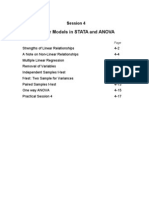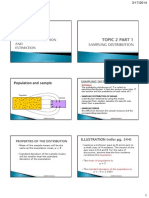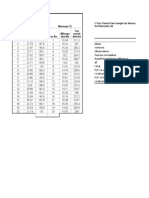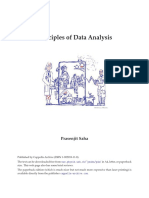Log Linear Notes
Uploaded by
n02017418vLog Linear Notes
Uploaded by
n02017418vLog-linear Models
The classical log-linear models are tools for analyzing relationships among two or more categorical
variables. They are based on multi-dimensional joint frequency tables. In the sample, each cell in such a
table contains the number of cases with a particular combination of values of the variables. In the
population, each cell in our multi-dimensional table contains a probability -- the probability of selecting a
case with that combination of values. This table is exactly the joint probability distribution of the variables
in the analysis.
If you multiply the probabilities by the size of the sample, you get expected frequencies. A "log-linear
model" is a statistical model for the natural logarithm of the expected frequency. It looks like a multiple
regression model with effect coding, in which the interaction terms correspond to associations among
variables. If the variables are unrelated (conditionally upon the values of other variables in the model), the
interaction terms are missing. The terms corresponding to main effects represent departures from equal
marginal frequencies.
The model with terms corresponding to all possible main effects and interactions is called the saturated
model. In multiple regression, such a model would be estimated from the data with error. In loglinear
modelling, the saturated model always fits the data perfectly. There is the same number of terms in the
model as cell frequencies, the relationship between them is one-to-one, and that's it.
So you can't test the saturated model, but you can estimate a non-saturated model with software, and test
the difference between that one and the saturated model. Such tests are often called "goodness of fit" tests,
because they tell you whether the model in question is significantly worse than the saturated (perfect)
model. There are several good ways to conduct goodness of fit tests, but we will confine ourselves to
likelihood ratio tests. We really are testing the difference between a reduced model and a full model. In
this case, the full model is the saturated model.
If the reduced model is true (that's the null hypothesis), the likelihood ratio statistic (minus two times the
natural log of the likelihood function evaluated at the MLE, if you know what that means) has a distribution
that approaches a chi-square distribution as the sample size increases. The degrees of freedom are the
STA442s04 Loglinear Models:
Page 1
number of terms present in the saturated model but missing from the reduced model.
Often, the tests that are really interesting can be expressed as the difference between the saturated model and
a carefully chosen reduced model. You are testing (simultaneously) all the associations among variables
that are absent in the reduced model. Sometimes, especially when four or more variables are involved,
what you are interested in may correspond to the difference between a reduced model and an even more
reduced one. In this case, the difference between -2 log(likelihood) of the two models will have a chi-
square distribution with df equal to the difference in degrees of freedom -- provided that the terms in the
more reduced model are a subset of the terms in the less reduced one. That is, the models have to be
nested in order for the large-sample likelihood ratio tests to be valid. If you do this, please at least be sure
that your less restricted model (that's your new "full" model that's not the saturated model) fits the data
fairly well. At the very least, it should not fit significantly worse than the saturated model.
In order to avoid ambiguities and tricky problems interpreting results, we will confine ourselves to
hierarchical log-linear models. Hierarchical means that if an effect is present in a model, then all the
lower-order effects that make it up must also be in the model. For example, if a model contains a three-way
A by B by C association, then it must also contain A, B, C, A by B, A by C and B by C.
For hierarchical models, there is a very convenient bracket notation for expressing association and lack of
association among variables, especially if the variables can all be represented with single symbols like
letters or numbers. Just enclose sets of variables that are associated within the same set of brackets. A
variable that does not appear at all has equal marginal frequencies. For example,
° For three variables numbered one through three, the model [1] [2] [3] allows each variable to
have unequal marginal frequencies, but it contains no relationships among variables. It is a model of
complete independence. If the test for goodness of fit is significant, the conclusion is that there is some
relationship among variables. This is not a bad place to start in any analysis.
° The model [1,2] [1,3] [2,3] allows for lack of independence in each of the three two-way
marginal tables. Because the model is hierarchical, the three single-variable terms are implicitly present.
The only term that is missing from this model is the three-factor relationship 1*2*3, so the test for
goodness of fit is a test for whether, equivalently,
STA442s04 Loglinear Models:
Page 2
* The relationship between 1 and 2 is the same for all values of variable 3
* The relationship between 1 and 3 is the same for all values of variable 2
* The relationship between 2 and 3 is the same for all values of variable 1
That is, it is analogous to a two-factor interaction in the normal linear model.
° The model [1,2] [1,3] says that the only thing going on is (possibly) a relationship between
Variables 1 and 2, and a relationship between 1 and 3. Any apparent relationship between 2 and 3 arises
from the fact that they are both related to 1. This is a model of conditional independence. That is,
conditionally on (controlling for) the value of Variable 1, Variables 2 and 3 are unrelated.
You can get the test statistic for this model another way. Produce separate two-way tables of Variable 2 by
Variable 3 -- one for each value of Variable 1. This is the subdivision approach to controlling for Variable
1. Add the chisquare values for testing independence in the sub-tables. Under the null hypothesis that
Variables 2 and 3 are independent for each fixed value of Variable 1, the sum of chisquares has a chisquare
distribution, with degrees of freedom equal to the sum of degrees of freedom from the sub-tests. If you
add likelihood ratio chi-squares, you get the standard test of conditional independence for loglinear models.
But adding Pearson chi-squares is valid too.
By the way, suppose the test just described is significant. To see where the effect comes from, try looking
one-at-a-time at the chi-square statistics you just added up. It would be best to apply a Bonferroni
correction.
This is a good way to slice up a test for conditional independence, but it is not the only good way. The
model [1,2] [1,3] lacks two terms that are present in the saturated model. They are 2*3 and 1*2*3. If we
added just the first one to the model [1,2] [1,3], we would get [1,2] [1,3] [2,3]. This says that Variables 2
and 3 may be related, but if so they are related in the same way for all values of Variable 1. To test for
this limited form of dependence of 2 and 3, use [1,2] [1,3] [2,3] as the full model and [1,2] [1,3] as the
reduced model. Again, the test statistic is the difference in -2 times the log likelihood for the two models,
distributed as chisquare with df equal to the difference in degrees of freedom. The numbers are quite easy
to locate on the printout from SAS proc catmod. By the way, this all works out because the two models are
nested. The terms in [1,2] [1,3] are a subset of the terms in [1,2] [1,3] [2,3].
STA442s04 Loglinear Models:
Page 3
Next, you can test for the other piece of departure from conditional independence, by testing the goodness
of fit of [1,2] [1,3] [2,3]. This tests [1,2] [1,3] [2,3] against the saturated model, equivalently testing
for 1*2*3. Again the models are nested.
° Suppose you want to test association between two sets of variables. For example, suppose
Variables 1 through 4 represent employment history, and Variables 5 through 8 represent employment
history of the parent (of the same sex). The model to test against the saturated model is [1234] [5678].
This model says that the employment history variables may be related any way at all, and parental
employment history variables may be related any way at all, but the employment history variables are
completely independent of the parental employment history variables.
In the theory of log-linear models, there is no distinction between independent variables and dependent
variables. But there are some situations where you want to make the distinction. Say, two or more of the
variables are randomly assigned. It is possible to develop a separate theory for this situation, but it turns out
that as long as the reduced model contains all possible associations among independent variables (even if
they are set up to be unrelated), classical loglinear models yield exactly the same test statistics. This leads
to the following simple rule. If you want to make a distinction between independent and dependent
variables, just include all possible associations among independent variables in the model.
STA442s04 Loglinear Models:
Page 4
You might also like
- COX, D. R. HINKLEY, D. V. Theoretical Statistics. 1974 PDF100% (4)COX, D. R. HINKLEY, D. V. Theoretical Statistics. 1974 PDF522 pages
- SAHADEB - Categorical - Data - Lecture3No ratings yetSAHADEB - Categorical - Data - Lecture384 pages
- Chapter 4: Transformations of Variables: Box-Cox Tests of Functional SpecificationNo ratings yetChapter 4: Transformations of Variables: Box-Cox Tests of Functional Specification16 pages
- Applied Statistics II Chapter 7 The Relationship Between Two VariablesNo ratings yetApplied Statistics II Chapter 7 The Relationship Between Two Variables73 pages
- Descriptive Stats (E.g., Mean, Median, Mode, Standard Deviation) Z-Test &/or T-Test For A Single Population Parameter (E.g., Mean)No ratings yetDescriptive Stats (E.g., Mean, Median, Mode, Standard Deviation) Z-Test &/or T-Test For A Single Population Parameter (E.g., Mean)43 pages
- Problem Set 2 Quantitative Methods UNIGENo ratings yetProblem Set 2 Quantitative Methods UNIGE10 pages
- Model Selection Loglinear Analysis ExplainedNo ratings yetModel Selection Loglinear Analysis Explained4 pages
- Q.1 Explain The Underlying Ideas Behind The Log It Model. Explain On What Grounds Log It Model Is An Improvement Over Linear Probability Model. AnsNo ratings yetQ.1 Explain The Underlying Ideas Behind The Log It Model. Explain On What Grounds Log It Model Is An Improvement Over Linear Probability Model. Ans17 pages
- 1 Loglinear Models For Contingency TablesNo ratings yet1 Loglinear Models For Contingency Tables12 pages
- Module 2 - Section 4 (Linear Regression) - 11No ratings yetModule 2 - Section 4 (Linear Regression) - 1120 pages
- Allama Iqbal Open University, Islamabad: (Department of Secondary Teacher Education)No ratings yetAllama Iqbal Open University, Islamabad: (Department of Secondary Teacher Education)7 pages
- 2-04 Non-linear Models - Quadratic and Polynomial ModelsNo ratings yet2-04 Non-linear Models - Quadratic and Polynomial Models16 pages
- Item Regression: Multivariate Regression ModelsNo ratings yetItem Regression: Multivariate Regression Models41 pages
- Linearly Independent, Orthogonal, and Uncorrelated VariablesNo ratings yetLinearly Independent, Orthogonal, and Uncorrelated Variables2 pages
- Models for Polytomous Responses AA 2016-2017No ratings yetModels for Polytomous Responses AA 2016-201748 pages
- Choosing A Significance Test ObjectivesNo ratings yetChoosing A Significance Test Objectives15 pages
- Lecture 22: Introduction To Log-Linear Models: Dipankar Bandyopadhyay, PH.DNo ratings yetLecture 22: Introduction To Log-Linear Models: Dipankar Bandyopadhyay, PH.D59 pages
- Looking at Data: Relationships - : Caution About Correlation and Regression The Question of CausationNo ratings yetLooking at Data: Relationships - : Caution About Correlation and Regression The Question of Causation20 pages
- Machine Learning. Supervised Learning Techniques and Tools: Nonlinear Models Exercises with R, SAS, Stata, Eviews and SPSSFrom EverandMachine Learning. Supervised Learning Techniques and Tools: Nonlinear Models Exercises with R, SAS, Stata, Eviews and SPSSNo ratings yet
- T.A. Pai Management Institute Manipal: Submitted To: Prof. Sudhindra SNo ratings yetT.A. Pai Management Institute Manipal: Submitted To: Prof. Sudhindra S15 pages
- Rocinante 36 Marengo 32 Mileage (KM/LTR) Top Speed (KM/HR) Mileage (KM/LTR) Top Speed (KM/HR)No ratings yetRocinante 36 Marengo 32 Mileage (KM/LTR) Top Speed (KM/HR) Mileage (KM/LTR) Top Speed (KM/HR)3 pages
- Dilla University: College of Natural and Computational Sciences100% (1)Dilla University: College of Natural and Computational Sciences38 pages
- Research Methodology and Biostatistics (NCISM)_Dr. Arun Raj GR & Dr. Kavya MohanNo ratings yetResearch Methodology and Biostatistics (NCISM)_Dr. Arun Raj GR & Dr. Kavya Mohan40 pages
- NCERT Solutions For Class 12 Maths Chapter 13 Probability Exercise 13.1No ratings yetNCERT Solutions For Class 12 Maths Chapter 13 Probability Exercise 13.122 pages
- Advanced Business Statistics For Decision Making: Facilitator-Dr. Shilpa Bhaskar MujumdarNo ratings yetAdvanced Business Statistics For Decision Making: Facilitator-Dr. Shilpa Bhaskar Mujumdar31 pages
- Oneway: ONEWAY Hasil BY Varietas /missing Analysis /posthoc Tukey Duncan LSD Alpha (0.05)No ratings yetOneway: ONEWAY Hasil BY Varietas /missing Analysis /posthoc Tukey Duncan LSD Alpha (0.05)10 pages
- Principles of Data Analysis - Prasenjit Saha (2003) PDFNo ratings yetPrinciples of Data Analysis - Prasenjit Saha (2003) PDF86 pages
- Statistical Analysis With Software ApplicationNo ratings yetStatistical Analysis With Software Application3 pages
- Hypothesis Testing: Example 1: Does A New Drug Improve Cancer Survival Rates?No ratings yetHypothesis Testing: Example 1: Does A New Drug Improve Cancer Survival Rates?25 pages
- Probability Distribution: Meaning Uses Types Assumptions Properties ApplicationsNo ratings yetProbability Distribution: Meaning Uses Types Assumptions Properties Applications19 pages
- 03 9709 62 2023 2RP Afp M23 13022023030714No ratings yet03 9709 62 2023 2RP Afp M23 1302202303071416 pages
- COX, D. R. HINKLEY, D. V. Theoretical Statistics. 1974 PDFCOX, D. R. HINKLEY, D. V. Theoretical Statistics. 1974 PDF
- Chapter 4: Transformations of Variables: Box-Cox Tests of Functional SpecificationChapter 4: Transformations of Variables: Box-Cox Tests of Functional Specification
- Applied Statistics II Chapter 7 The Relationship Between Two VariablesApplied Statistics II Chapter 7 The Relationship Between Two Variables
- Descriptive Stats (E.g., Mean, Median, Mode, Standard Deviation) Z-Test &/or T-Test For A Single Population Parameter (E.g., Mean)Descriptive Stats (E.g., Mean, Median, Mode, Standard Deviation) Z-Test &/or T-Test For A Single Population Parameter (E.g., Mean)
- Q.1 Explain The Underlying Ideas Behind The Log It Model. Explain On What Grounds Log It Model Is An Improvement Over Linear Probability Model. AnsQ.1 Explain The Underlying Ideas Behind The Log It Model. Explain On What Grounds Log It Model Is An Improvement Over Linear Probability Model. Ans
- Allama Iqbal Open University, Islamabad: (Department of Secondary Teacher Education)Allama Iqbal Open University, Islamabad: (Department of Secondary Teacher Education)
- 2-04 Non-linear Models - Quadratic and Polynomial Models2-04 Non-linear Models - Quadratic and Polynomial Models
- Linearly Independent, Orthogonal, and Uncorrelated VariablesLinearly Independent, Orthogonal, and Uncorrelated Variables
- Lecture 22: Introduction To Log-Linear Models: Dipankar Bandyopadhyay, PH.DLecture 22: Introduction To Log-Linear Models: Dipankar Bandyopadhyay, PH.D
- Looking at Data: Relationships - : Caution About Correlation and Regression The Question of CausationLooking at Data: Relationships - : Caution About Correlation and Regression The Question of Causation
- Gale Researcher Guide for: Econometric ModelsFrom EverandGale Researcher Guide for: Econometric Models
- Machine Learning. Supervised Learning Techniques and Tools: Nonlinear Models Exercises with R, SAS, Stata, Eviews and SPSSFrom EverandMachine Learning. Supervised Learning Techniques and Tools: Nonlinear Models Exercises with R, SAS, Stata, Eviews and SPSS
- T.A. Pai Management Institute Manipal: Submitted To: Prof. Sudhindra ST.A. Pai Management Institute Manipal: Submitted To: Prof. Sudhindra S
- Rocinante 36 Marengo 32 Mileage (KM/LTR) Top Speed (KM/HR) Mileage (KM/LTR) Top Speed (KM/HR)Rocinante 36 Marengo 32 Mileage (KM/LTR) Top Speed (KM/HR) Mileage (KM/LTR) Top Speed (KM/HR)
- Dilla University: College of Natural and Computational SciencesDilla University: College of Natural and Computational Sciences
- Research Methodology and Biostatistics (NCISM)_Dr. Arun Raj GR & Dr. Kavya MohanResearch Methodology and Biostatistics (NCISM)_Dr. Arun Raj GR & Dr. Kavya Mohan
- NCERT Solutions For Class 12 Maths Chapter 13 Probability Exercise 13.1NCERT Solutions For Class 12 Maths Chapter 13 Probability Exercise 13.1
- Advanced Business Statistics For Decision Making: Facilitator-Dr. Shilpa Bhaskar MujumdarAdvanced Business Statistics For Decision Making: Facilitator-Dr. Shilpa Bhaskar Mujumdar
- Oneway: ONEWAY Hasil BY Varietas /missing Analysis /posthoc Tukey Duncan LSD Alpha (0.05)Oneway: ONEWAY Hasil BY Varietas /missing Analysis /posthoc Tukey Duncan LSD Alpha (0.05)
- Principles of Data Analysis - Prasenjit Saha (2003) PDFPrinciples of Data Analysis - Prasenjit Saha (2003) PDF
- Hypothesis Testing: Example 1: Does A New Drug Improve Cancer Survival Rates?Hypothesis Testing: Example 1: Does A New Drug Improve Cancer Survival Rates?
- Probability Distribution: Meaning Uses Types Assumptions Properties ApplicationsProbability Distribution: Meaning Uses Types Assumptions Properties Applications

























































































